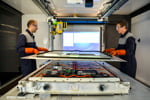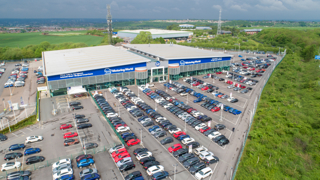This is despite the fact that it has already laid off 71 of its 260 staff and is unable to guarantee the future of the remaining workforce when the factory closes in six months.
TVR has called the cut backs “regrettable”, but says the move was necessary to secure its long-term stability and foothold within the competitive low-volume sports car industry. It now plans to relocate some of the assembly process to a more “suitable” facility, possibly close to Blackpool, but will not give any details.
There will be a production gap while machinery is moved from Blackpool to the new location, but TVR is confident it can stockpile sufficient models to ensure dealers do not face a shortfall in supply. The new site is expected to be larger than Blackpool and will include newer tools to help the sportscar maker raise build quality levels.
The Transport and General Workers Union (TGWU) says the closure announcement is a devastating blow that has left the workforce stunned. However, TVR hopes to remain in the area but warns that it could relocate elsewhere in the UK if it can not find suitable premises.
“The cars will continue to be hand-built to customers’ orders by highly skilled craftsmen, but the impressive new technology, processes and techniques with which they’ll be constructed and tested are considerably more advanced,” says TVR marketing director Ian Law.
“The logistics of the business will also be modernized to improve the availability of parts and the time frames in which they’re delivered. The entire change over has been carefully planned to minimize disruption,” he adds.
The announcement comes less than two years after TVR was bought for £15m by 24-year-old Russian oil tycoon Nikolai Smolensky. At the time he claimed that the “best automotive designers and engineers are in this country” and promised to invest heavily to enhance the brand as a global player. But in 2004, the last year for which accounts have been filed, the company made a loss of £11.8m.
Last year, TVR made 712 cars but production has fallen from around 12 cars a week to just six.
TVR blames falling demand caused by customers waiting for new models due next year. It is now hoping to achieve Euro IV emissions approval, which will allow it to sell more cars in Europe and the lucrative US and Middle East markets.
“Although slow winter sales hit the automotive industry as a whole, sales have not slumped generally, with demand remaining fairly constant for a number of years. The company remains highly optimistic about its future,” says Law.
#AM_ART_SPLIT# A brief history of TVR
1947: TVR founded by Trevor Wilkinson under the name of Trevcar Motors
1962: TVR goes into receivership
1965: Bought my Martin Lilley
1981: Sold to Peter Wheeler
1997: Announces a redundancy programme to the 650-strong workforce due to falling demand
September 2002: Withdraws from six prestige marque dealers as it aims to create open points for “enthusiastic and professional entrepreneurs”
June 2004: Fires six dealers who were deemed “not suitable”
July 2004: TVR bought from Peter Wheeler by Nikolai Smolensky for £15m. Employs 500 workers
February 2005: Lays off 90 body shop staff
April 2005: Invests in a new dealership in West London July 2005 Announces losses for 2004 of more than £11m
January 2006: Warned by the OFT after failing to supply independent repairers with parts
February 2006: Announces it wants to recruit four or five more UK dealers by March
February 2006: TVR invests £120,000 on a stand at the London Motor Show
April 2006: 71 workers laid off and closure of Blackpool Factory announced. Remaining 190 staff told they have no “guaranteed future”

















Login to comment
Comments
No comments have been made yet.